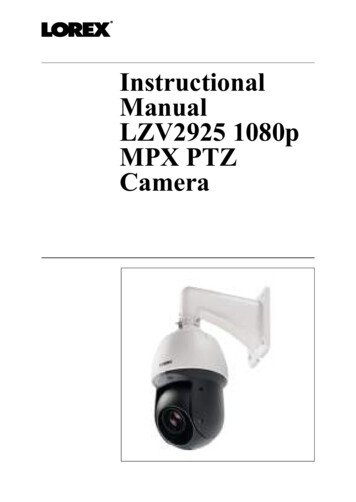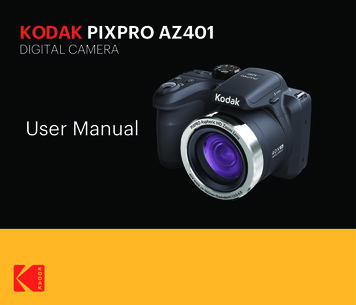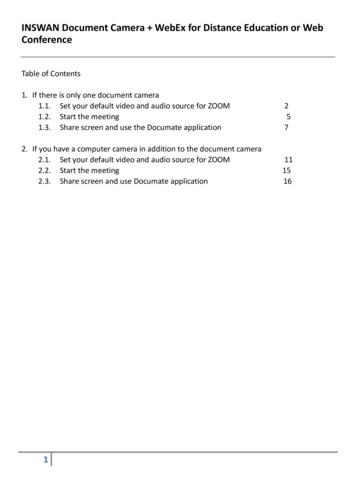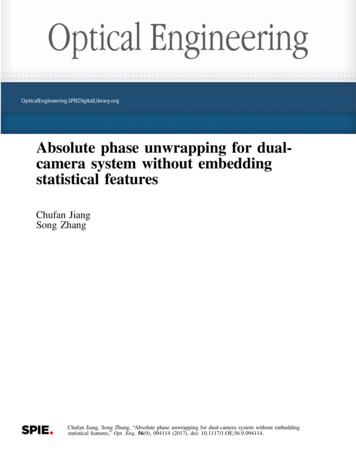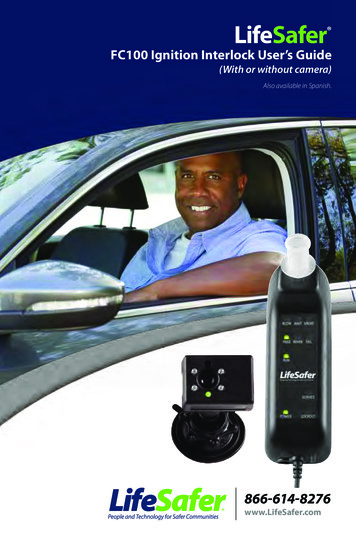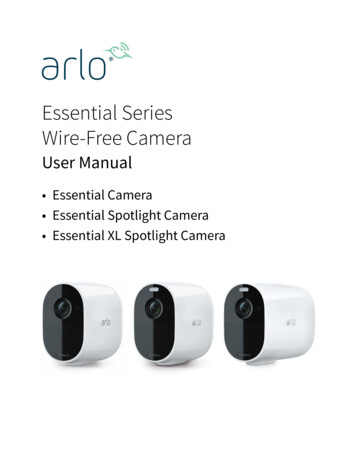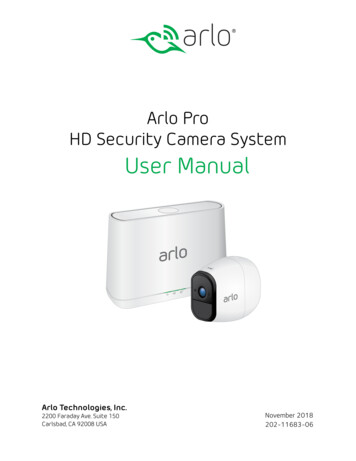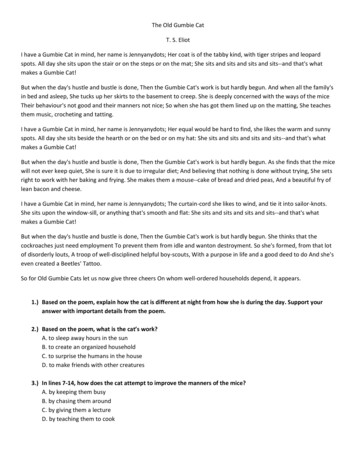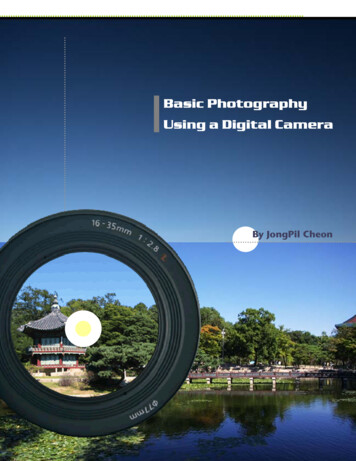
Transcription
Digital Camera FunctionsAll photography is based on the same optical principle of viewing objects withour eyes. In both cases, light is reflected off of an object and passes through alens, which focuses the light rays, onto the light sensitive retina, in the case ofeyesight, or onto film or an image sensor the case of traditional or digitalphotography.The shutter is a curtain that is placed between the lens and the camera thatbriefly opens to let light hit the film in conventional photography or the imagesensor in digital photography. The shutter speed refers to how long the curtainstays open to let light in. The higher the number, the shorter the time, andconsequently, the less light gets in. So, a shutter speed of 1/60th of a secondlets in half the amount of light than a speed of 1/30th of a second. For mostnormal pictures, shutter speeds range from 1/30th of a second to 1/100th of asecond. A faster shutter speed, such as 1/500th of a second or 1/1000th of asecond, would be used to take a picture of a fast moving object such as a racecar; while a slow shutter speed would be used to take pictures in low-lightsituations, such as when taking pictures of the moon at night. Remember thatthe longer the shutter stays open, the more chance the image will be blurredbecause a person cannot usually hold a camera still for very long. A tripod orother support mechanism should almost always be used to stabilize the camerawhen slow shutter speeds are used.Now, let's look at aperture. The aperture is actually part of the lens, not thecamera. It is a circular, adjustable opening that functions much like the lens ofthe eye. It opens wide in low light situations to let in more light, and closes downto a small opening in brightly lit situations to let in less light. The size of theopening of the lens aperture is measured in numerical values called f-stops.Typical f-stops are f2.8, f-4, f-5.6, f-8, f-11, f-16 and f-22. The larger thenumber, the smaller the opening. Increasing the size of the aperture by one fstop doubles the amount of light that enters the lens.
the aperture settings on a lens corresponds to how wide the lens opens whena picture is taken.photo from: http://www.scphoto.com/html/camera.htmlA good description of aperture, shutter and depth of field is online at:http://www.ted.photographer.org.uk/photoscience control.htmAnother online resource that describes the lens aperture - be sure to scroll all theway to the bottom of the page:http://www.freehandsource.com/ frames/ tips/ archive/tip week111.htmlEven more information about shutter speed can be found at:The Shutter Controls Light and %20and%20MotionAutomatic vs. Manual Shooting Modes
Automatic Shooting ModesAll photography, including digital photography, involves light being reflected offof objects and being captured by film or in the case of digital cameras, imagesensors. If too much light hits the sensor, the image will be overexposed and thepicture will look overly bright and the colors will appear washed out. If notenough light hits the sensor, the image will be underexposed and will appeardark and difficult to see details in the picture.Many of the newer higher-end digital cameras and digital SLR (Single LensReflex) cameras have a variety of small pictures on a dial that indicate thevarious exposure settings the cameras are capable of using. As you will see inthe images below, most digital cameras have similar controls for their variousexposure settings.CanonNikonKonica MinoltaFully Automatic ModeJust about all digital cameras use some type of automatic mode for determiningthe correct exposure of pictures. On some cameras you will see the term Autoor AE which stands for Automatic Exposure. On the Canon Digital Rebel, thefully automatic exposure setting is designated by the green square. Just about alldigital cameras, regardless of their type or cost, provide a fully automaticexposure mode that makes all the decisions for you. The electronics in thecamera work with the image sensor to evaluate the light, select the correct ISO,perform the white balance and then set the aperture and the shutter speed toget the best exposed image. Most cameras also automatically control a built-inflash and have it fire when the lighting conditions make it necessary.There is nothing wrong with letting the camera make decisions for you, as thistakes much of the guess work out of taking pictures and lets the photographerconcentrate on finding the subject and then framing and composing the image.However, many photographers like to have some measure of control so that they
can be more creative and have the ability to customize the pictures they take.With the level of sophisticated electronics in today's digital cameras and theability to take very high resolution images, how much control to leave to thecamera and how much to retain for yourself is a decision that everyphotographer will have to make for her or himself. But having some knowledgeabout what is possible can aid in this decision making process.Programmed AE/Program Mode (P)Program Mode is similar to Fully Automatic but lets you change some settings,such as whether the flash will fire or not, and the type of metering the camerawill use when taking a picture.Aperture Priority (Av)Aperture Priority mode allows the photographer to set the size of the aperture,also known as the f-stop, and then have the camera decide what shutter speedwill be used to take a correctly exposed image.Shutter Priority (Tv)Shutter Priority mode is just the opposite of Aperture Priority in that it allows thephotographer to set the shutter speed and then have the camera decide the sizeof the aperture's opening to take a correctly exposed image.Other ModesPortraitSets the camera for minimum depth of field so that the background of theportrait will have a soft and less distracting look.LandscapeThe reverse of the portrait mode, sets the camera for maximum depth of field sothat everything in the picture will be in focus. This mode works best when usinga wide angle lens (a lens with a shorter focal distance).Close-UpThis mode is used when taking pictures of small objects. However, this is not thesame as using a macro lens, which we will explore later.SportsUsed to stop motion when taking pictures of fast-moving objects, such asathletes at sporting events. On some cameras, this mode works in conjunctionwith the auto-focus mechanism to keep moving subjects in focus. In this mode,
the camera may also be set to burst, to continuously take pictures while theshutter release is held down.Night PortraitThis mode is used to take pictures of people under low light conditions, such asdawn, evening and night. When the subjects are in the foreground, a slowershutter speed will be used to lighten the background and a fill-in flash will fire toilluminate the foreground objects.Flash OffAs the name suggests, this mode turns the flash off.Manual Exposure (M)Allows you to select the shutter speed and the aperture so that you have controlover the amount of light, the amount of motion and the depth of field in yourpictures.Auto Depth of Field (A-DEP)This setting is used so that the camera's automatic focusing capability evaluatesvarious locations within the field of view and then selects the aperture settingthat will provide enough depth of field to keep everything in focus.Exposure CompensationExposure Compensation lets you override the camera's automatic exposuresetting, usually in 1/3, 1/2 or 1 f-stop increments, either on the plus side formore exposure, or on the minus side for less exposure.Exposure LockMany cameras have this capability that lets you maintain the previous exposurevalue for additional pictures.Depth of FieldDepth of field is an important concept in photography and helps determine thefocus of foreground and background elements and how they relate to eachother. This relationship between items closer to the camera and those fartheraway can be modified through the effective use of depth of field.In the following series of images, you will see four different objects, a head, abird, a vase and a fence, all in various stages of focus. By manipulating the
camera's aperture and shutter speed, the photographer can determine which ofthe four individual objects will be in sharpest focus and which will be out offocus. This is important because at times, you will want to the viewer to payclosest attention to specific elements in your picture and using depth of filed is agood way of accomplishing this.These images were taken either with the camera set to manual exposure or byusing the auto depth of field setting.Only the Head is in Sharp Focusf/7.1 1/80th of a secondfocal length 51mmOnly the Bird is in Sharp Focus
f/5.6 1/60th of a secondfocal length 45mmOnly the Vase is in Sharp Focusf/5.6 1/100th of a secondfocal length 46mmOnly the Fence is in Sharp Focusf/5.6 1/60th of a secondfocal length 45mm
All Four Objects are in Sharp Focusf/36 1/4th of a secondfocal length 51mmShutter Speed and Depth of FieldShutter SpeedThe shutter speed of a camera determines how long of an exposure is made, inother words how long light will travel through the lens to expose the film or adigital camera's sensor.In the images below, you should look closely at the water coming out of thefountain's faucet.
With the shorter shutter speeds, such as 1/250th of a second, the water iscaptured in mid-stream and on close examination, some of the individual dropscan be seen.
f/8 - 1/250th of a secondBut as the shutter speed is set to longer numbers (remember that the shutterspeed indicates the amount of time that the shutter remains open letting light hitthe camera's image sensor), the water drops begin to merge together until itlooks like the water has been painted, rather than captured by a camera.
f22- 1/2 second
The photograph below of the UH fountain sculpture behind the College ofEducation building, taken by Will Rowell - a student in an earlier DigitalPhotography course, beautifully captures this effect by using a long exposure ofabout 15 seconds.
Obviously, in a case such as this one, the camera must be extremely still whilethe shutter is open. This can be done by resting the camera on a stable surface,such as a bench, or preferably, by using a tripod. You will also notice that theimage shows a horizontal curve to the ground and the buildings beingphotographed. This is because the lens used to take this picture has a very wideangle of view which distorts the true perspective of the subject. Another attributeof a wide angle lens such as the one used here, is that there is a high depth offield, so that everything in the picture is in focus.
photography. The shutter is a curtain that is placed between the lens and the camera that briefly opens to let light hit the film in conventional photography or the image sensor in digital photography. The shutter speed refers to how long the curtain stays open to let l
